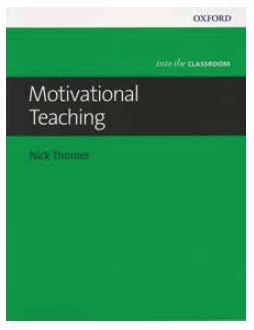Motivational Teaching by Nick Thorner
Motivational Teaching by Nick Thorner
OUP 2017 978-0-19-420042-4

Motivation is an area of teaching that all teachers strive to improve on. Motivating a group of students can be quite a challenge, as what one class might find motivating others might find highly demotivating.
Motivational Teaching offers a wealth of tips and ideas for increasing motivation in the language classroom. The book is intended for teachers of primary and secondary school students, but many of the techniques and tasks could be used with adult learners as well. In fact, the author’s stated aims include raising learner motivation across ages, abilities and backgrounds.
The book is divided into three parts. Part 1, ‘An Individual Learner’, focuses on the learners and how we can help them become more motivated. Chapter 1, ‘A love of language learning?’, provides information about intrinsic motivation, or learning out of enjoyment or interest. Thorner here suggests ways that teachers can help their students to find enjoyment in learning, such as emphasising the pleasurable aspects of learning and language. Chapter 2, ‘Reflecting on the future’, is about instrumental motivation, or learning with an eye on goals. In this chapter, the author recommends using activities involving the ideal future self, the ‘ought to’ self, and the present self. Chapter 3, ‘Seeing progress’, emphasises getting students to dwell on how much they’ve learnt, employing goal setting and progress orientation. Part 1 concludes with Chapter 4, ‘Motivating specific behaviours’. This chapter provides numerous tips for changing and improving students’ behaviour, such as increasing awareness, giving rewards and modelling.
The learning environment of the classroom is the theme of Part 2, ‘The Learning Context’, which explains and describes the important features of building a motivating classroom space one by one. Chapter 5, ‘Teacher behaviour’, demonstrates how starting and ending lessons properly, maintaining a proper pace and giving feedback in the right way can all have a profound impact on motivation. Chapter 6, ‘The learning environment’, focuses on the physical environment of the classroom. This chapter offers clever ideas about using space and wall space and decoration, as well as multisensory spaces and the social environment. Learner roles is the theme of Chapter 7, which talks about giving students more independence and freedom in class. Chapter 8 is titled ‘Motivating materials’, and it recommends a number of ways of exploiting coursebooks, digital media and content-based materials. The final chapter of Part 2, ‘Task design’, looks at the role of lesson planning and motivation, and advocates adding elements of creativity, challenge, choice and collaboration.
Part 3 is entitled ‘Issues In Motivation’, and goes into the background factors that relate to motivation. Chapter 10, ‘Students as individuals’, covers age, gender, aptitude and special educational needs (SEN). Chapter 11, ‘Student background’, shows how a student’s family background, cultural background and learning background can affect motivation. The book reaches a satisfying conclusion with Chapter 12, ‘Teacher motivation’. This chapter provides a number of ideas for improving our own motivation as teachers, such as enriching the school environment and working together with colleagues in workshops and action research.
Each chapter is greatly enhanced by tips, which are featured in short sections titled ‘Getting It Right’. For example, Chapter 5 has a ‘Getting It Right’ section with valuable suggestions for dealing with students who come in late. Another brilliant feature of every chapter is the ‘Try This’ box, featuring a quick, low-prep activity based on the theme of the chapter. For example, in Chapter 9, there is a clever activity called ‘Presentations X Factor’, where the students critique video recordings of presentations live in the classroom. Each chapter concludes with a brief section called ‘Why This Works’, explaining some of the concepts behind the chapter theme and offering ideas for further exploration. The book contains a glossary, which will help readers understand terms such as locus of control, self-efficacy and temptation bundling. The author also includes a list of useful websites for readers who want to know more about the topics in the book.
I enjoyed Chapters 6 and 8 the most, as I often seek out alternative ways of using the classroom environment and materials to keep my students motivated. I plan to try out some of the ‘Try This’ activities from Chapter 8 next semester with my university students.
Overall, I was impressed by this book. It gave me much food for thought on the topic of motivation, from many different angles. It’s clear that the author is knowledgeable on the subject of motivation, and is skilled at developing fun, enjoyable activities that teachers will find useful. The only quibble I had is that the chapters are quite short, and at times, I wished they went into a little more detail on some topics. However, the book does contain a wealth of useful information for any teacher who wishes to increase motivation in his or her classroom.
Hall Houston
Luzhu, Taiwan

Comments
Write a Comment
Comment Submitted